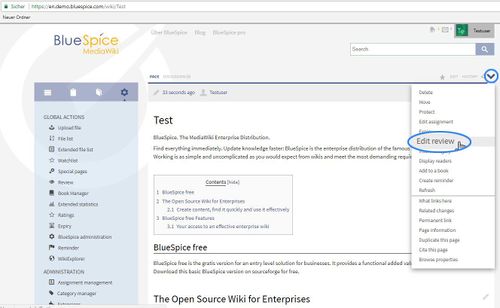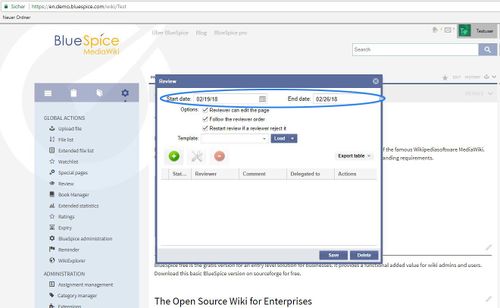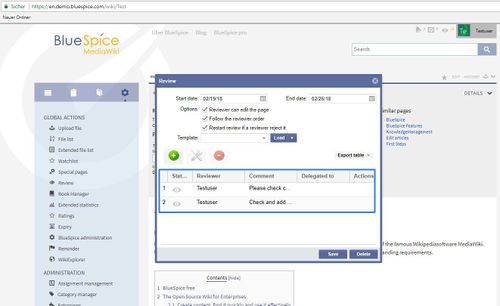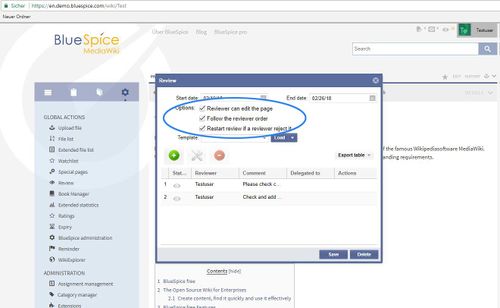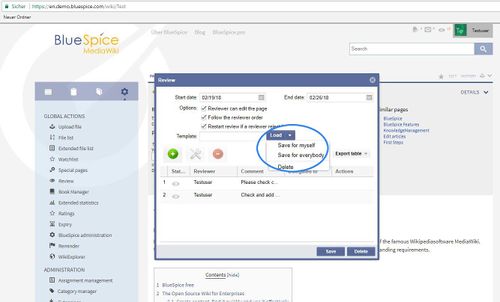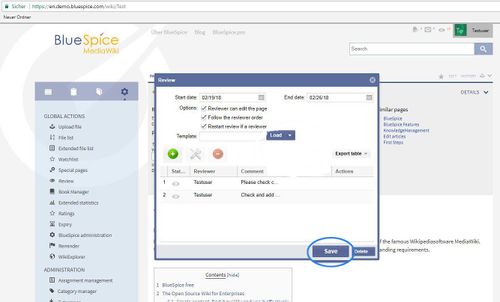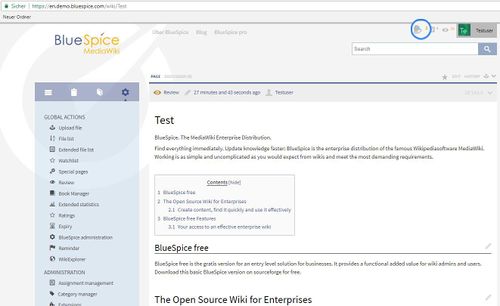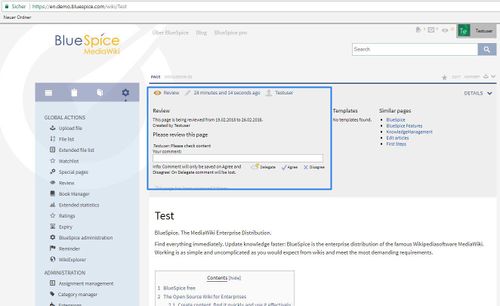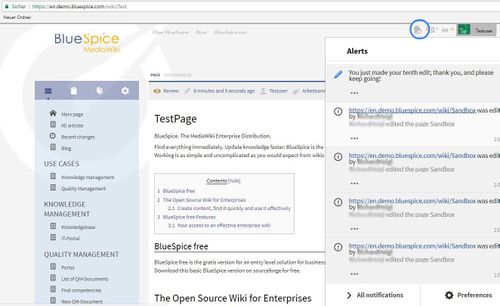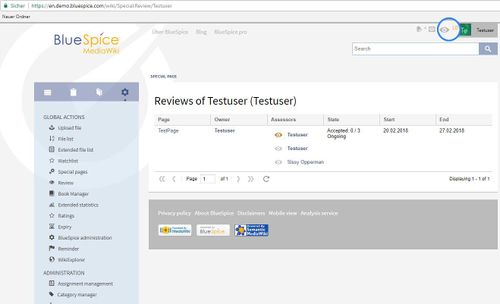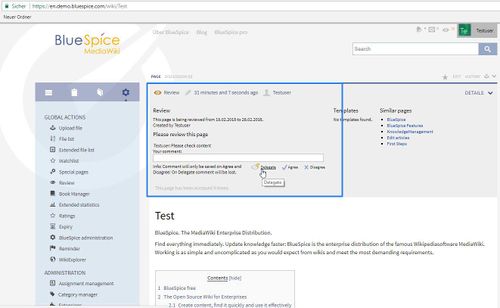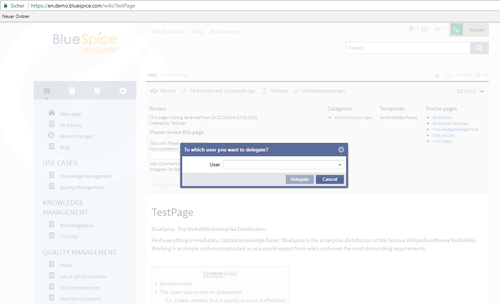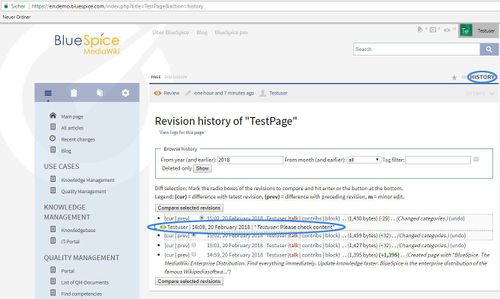Teamwork
-
- Last edited 7 years ago by Lsireta
-
-
- This page is expired
Contents
What is Teamwork?
Teamwork is a software package to support quality assurance through workflows.
The quality of the content of articles is very important, especially in a wiki that is frequented by many users. The package Teamwork for BlueSpice simplifies the assurance and control of this quality with many functions.
This includes the creation of review processes and the assignment of reviewers, as well as the creation and monitoring of whole workflows. By introducing draft versions and approval mechanisms, you can also control the publishing of new articles and changes without any difficulty.
Why to use Teamwork?
If in your organisation...
- Manuals and documentations need to be created in a specified process
- Articles have to be finished on a set date
- Work for the individual employee should be minimized by distributing editing bit by bit
- Quality in your wiki should be enhanced by approvals and fixed contact persons
- Cooperation in your wiki should be done "the professional way"
... then Teamwork is perfect for you!
Which extensions are part of Teamwork?
The package Teamwork consists of the following extensions:
- ReviewExtended is an extension for BlueSpice developed by Hallo Welt! and provides basic functionalities for Teamwork, which are needed for reviewing articles by certain users. The following actions are possible with ReviewExtended:
- Delegation and redelegation of review tasks
- Extendend settings for the creation of workflow processes (allow/disallow editing, follow the reviewer order, abort review if a reviewer rejects it)
- Creation and use of workflow templates
- Flagged Revisions is a MediaWiki extension which activates the approval mechanism. New versions of an article are initially marked as drafts, and remain so until a user with revision rights checks and approves the article. FlaggedRevisions was customized by Hallo Welt! to improve the cooperation with ReviewExtended.
- The FlaggedRevsConnector provides additional internal functionalities, which are needed to connect ReviewExtended and FlaggedRevisions.
How to use Teamwork? (Step-by-step)
Imagine a typical situation:
- You have an important article in your wiki that desperately needs revision. You want to make sure that the content of the article satisfies the quality requirements of your organization, but you're lacking the expert knowledge needed to check for mistakes. That's why you want to commission some colleagues to do this for you. For this, you need a review process.
Creating a workflow
Step 1: Call up the article you want to create a review workflow for.
Step 2: Click on More on the top right of the article to open the Widgetbar. Click on Edit review.
Step 3: In the following pop-up window, decide on a review period by choosing a start and an end date.
Step 4: By clicking on the green button you can now add the first reviewer for the article. You can specify the task by adding a comment. Click on Ok to fix the reviewer.
Repeat this step to add further reviewers.
By the way: in the column Actions you can edit individual reviewers, move them up in the list, or delete them from the workflow completely.
Step 5: Decide on additional settings for the workflow:
- Should the reviewers be able to edit the article?
- Is the reviewer order mandatory? If so, then the next reviewer on the list will only be informed of the task when the previous reviewer already checked and approved the article.
- Should the whole review process be aborted if a reviewer rejects the new version of an article? Otherwise the initiator of the workflow will be informed of a rejection and will become the next reviewer. After that, the workflow will begin anew.
Step 6 (optional): Save the workflow as reusable template. This can save you a lot of time when creating a new workflow, especially when you have a large amount of reviewers, because all settings and reviewers can be transferred to a new review process with one click. Enter any name for your template and click on Save for myself if you want to restrict access to the template to yourself, or click on Save for everybody if you want to make the template available for all users of the wiki.
Step 7: Click on save to activate the workflow and inform the first reviewer (or all of them at once, depending on your setting in step 5) of the new task.
Reviewing an article
Step 1: If you were added as a reviewer to a workflow, you can be informed about your task in 3 different ways:
- a) Via Email. You can directly access the article in question by clicking on a link.
- b) Via notification in the wiki.
You will be informed about a new review task immediately]]
- c) Via the Eye icon that will appear on the page of each reviewer when a review workflow was created. Here you can learn more about this topic.
Please keep in mind: To receive notifications about upcoming reviews, users need to adapt certain settings in their user profiles. Step 2: Call up the article you want to review and check the content. Pay attention to any comments the initiator of the workflow might have added to your task. Depending on the settings in the workflow, you may be able to edit the contents directly, to correct mistakes you notice on the spot. Step 3: After finishing the review, open the statebar of the article by clicking on Review. Here you will find detailed information aber the duration of the review process, as well as the creator of the workflow. You can now agree to the changes in the article, or disagree. It is also very helpful to add a comment, to explain your decision to other users. Optional: If you're not able (for whatever reason) to review an article, you can also delegate the task to another colleague. Here you can find more on this topic.
Here you can agree or disagree on an article, or delegate the review.
Approving an article
If the approval mechanism was activated in your wiki, the article to review might still be a draft or even a first draft, which can not be seen by other users. You can easily see if an article was already approved by looking at its statebar. Here you will find one of three color markings:
You can approve an article by clicking on the link Approve beside the color marking in the statebar.
Please note: articles created or changed by users with the right autoreview will be automatically approved on saving.
View own reviews
If you were appointed reviewer in a workflow, an eye icon will appear next to your user profile. The numbers beside the icon show on the one hand the number of workflows you are part of (left column), on the other hand the number of workflows you already finished (right column).
The Eye icon gives you an overview of existing and new workflows
A click on the icon will show you your personal overview page, where all workflows are listed that you are part of.
The overview page shows all active workshops
Delegate workflows
You can delegate the review of an article to another user in the statebar.
If a delegation is activated, the delegate and the workflow initiator will be informed via email.
After the delegate reviewed the article like a "normal" reviewer, he can redelegate the workflow via a link in the statebar to the original reviewer.
The reviewer and the initiator of the workflow will be informed via email about this as well.
Monitor progress
After you started a workflow, you will be informed on a regular basis via email about new developments in the review process.
The progress and the current status of all existing workflows can be seen on the special page Special:Review.
Approval in the version history
The approval of an article is also commented in the version history. This enables you to find out - even after several editings and approvals - which user approved which version when. Just click on the tab Version History on the upper right corner of the article. Versions with approval will be marked with approved by, followed by the respective user name.
By the way: If the extension VisualDiff is also installed in your wiki, approved versions are marked green in the version history.
Special pages
For a better overview and usability, the package Teamwork installs the following special pages:
| Page | Description |
|---|---|
Special:UnreviewedPages
|
Here you will find all articles that are marked as First Draft and still have to be reviewed and approved. |
Special:Pages_with_unreviewed_versions
|
Here you will find all articles that are marked as Draft. This means that there are several parallel versions of article, which have to be reviewed and approved. |
Special:Review
|
On this page you will find an overview of all active workflows in the wiki. |
Special:Review/Pagename
|
This page will show you the review workflow of the respective page. |
Working hints
- Create a flowchart for typical processes within your organization.
- Think about it: which user groups need which rights in your wiki? This has e.g. influence on who will be able to approve articles later on.
- Which content is compulsory? This means that once it is public, it will be binding. This is often the case with organizational handbooks, where it is very important to use approval mechanisms, because a simple review won't be enough. Instead, someone who is responsible for the content of this area should control and approve version changes. Then, once the article is marked as approved, it will be an up-to-date and binding version.
- Is there content where free editing is desired? When there is a standard approval process, this could otherwise lower the impetus of users to edit content.
- Do you want to further distinguish between different possibilities to review an article? Should there be e.g. responsible editors for certain parts of the content? In that case it might be worth to take a look at Responsible Editors.
- Remember to set "Review" rights in the Permission Manager and grant these rights to the respective user groups in the Group Manager.
- If applicable, create first workflow templates, to save time later. This is especially handy when certain users have the same task in the workflow of several articles.
- Remember to advise your reviewers to check the Email notifications in their user profile.
See also
Our reference page.
